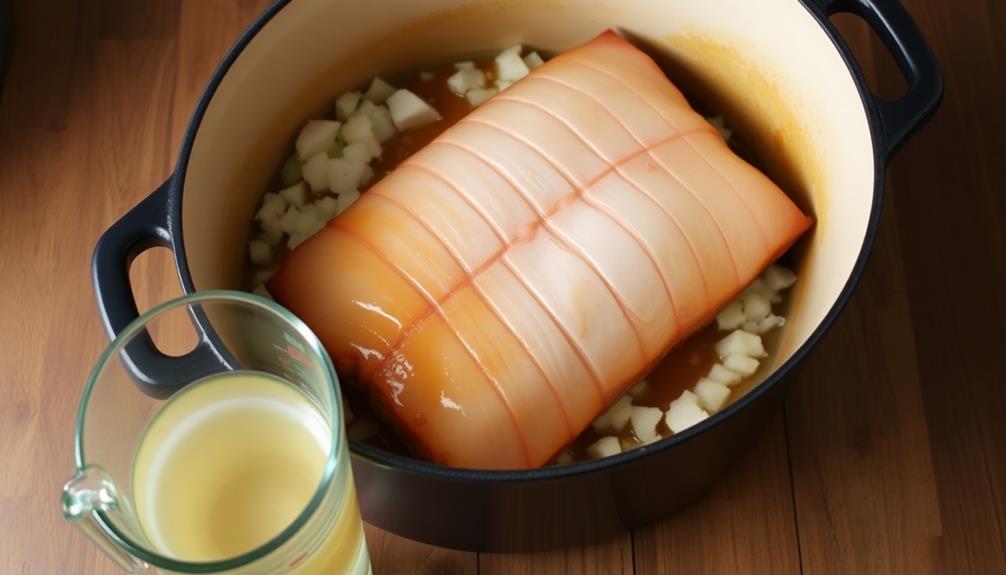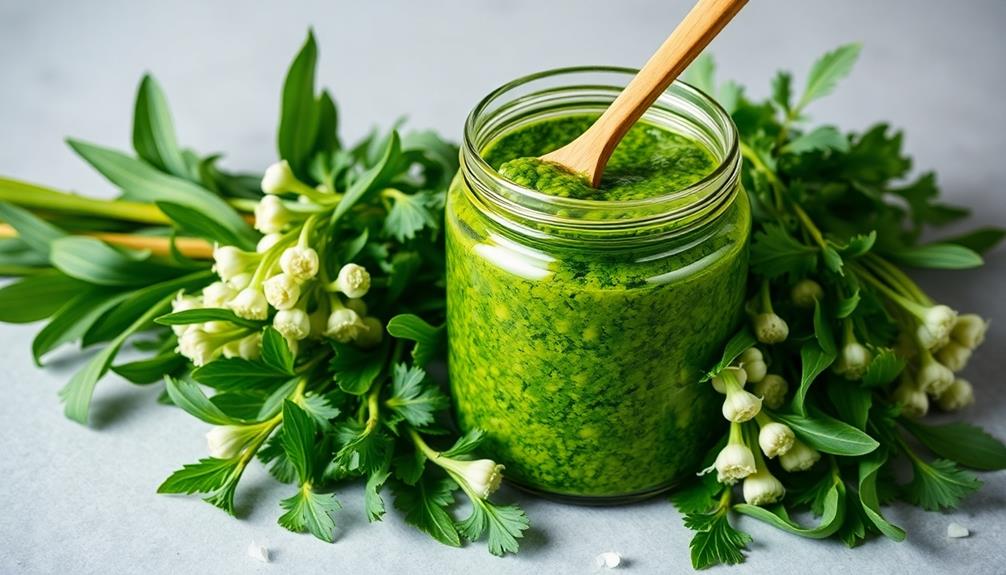Slow-cooked pork belly is a celebrated dish that's captivated culinary traditions worldwide. Its origins trace back to ancient Chinese and Korean cuisines, and today it's a staple from Asia to Europe. The key? Patience – the long, slow cooking process transforms fatty pork into a melt-in-your-mouth delight, balancing crispy skin and succulent meat. All you need are simple ingredients like pork belly, salt, and broth. After searing, let the slow cooker work its magic for 8-10 hours, then rest and serve. The rich, flavorful result is worth the wait – and there's more to discover about this beloved dish.
Key Takeaways
- Slow-cooked pork belly delivers a melt-in-your-mouth texture by transforming fatty pork into a tender delight through a long cooking process.
- The cooking method allows for maximum tenderness and flavor absorption, achieving a balance of crispy skin and succulent meat.
- Slow cooking the pork belly in a simple broth intensifies the natural flavors, creating a deeply satisfying and rich dish.
- Allowing the pork belly to rest after cooking is essential to redistribute the juices, enhancing the overall eating experience.
- Slow-cooked pork belly is considered a labor of love, but the end result rewards the effort with an irresistible and flavorful meal.
History
Tracing its origins to ancient Chinese and Korean cuisines, pork belly has long been a cherished ingredient in various culinary traditions. This versatile cut of meat, with its mouthwatering layers of succulent fat and tender, flavorful flesh, has captured the hearts and palates of food enthusiasts for centuries.
Throughout history, pork belly has been a staple in the diets of many cultures, from the sizzling street food of East Asia to the slow-cooked delicacies of European cuisines. Its ability to absorb and enhance a wide range of seasonings and cooking methods has made it a favorite among home cooks and professional chefs alike.
Whether braised, roasted, or grilled, pork belly has consistently delivered a rich, satisfying eating experience that has stood the test of time.
Today, the popularity of pork belly continues to grow, as more and more people discover the joys of this beloved cut of meat and its diverse culinary applications. Its history is a testament to its enduring appeal and the timeless pleasure it brings to the table.
Recipe
Slow-Cooked Pork Belly is a melt-in-your-mouth dish that rewards patience and careful preparation. The long, gentle cooking process transforms the rich, fatty pork into a sublime, tender delight. This recipe captures the essence of this classic dish, guiding you through the steps to achieve the perfect balance of crispy skin and succulent meat.
The key to success lies in the slow cooking method, which allows the connective tissues to break down and the flavors to meld together seamlessly. The result is a pork belly that's both decadent and deeply satisfying, perfect for sharing with family and friends.
- 3 lbs pork belly, skin on
- 2 tbsp sea salt
- 1 tsp black pepper
- 1 tbsp brown sugar
- 2 cloves garlic, minced
- 1 onion, diced
- 1 cup chicken or vegetable broth
Preheat your oven to 275°F. Score the pork belly skin in a criss-cross pattern, being careful not to cut too deeply into the meat. Rub the salt, pepper, and brown sugar all over the pork belly, making sure to get the seasoning into the scored skin.
Place the pork belly, skin-side up, in a large, oven-safe Dutch oven or heavy-bottomed pot. Add the garlic and onion around the pork. Pour the broth into the bottom of the pot. Cover the pot with a tight-fitting lid or aluminum foil. Place the pot in the oven and cook for 3-4 hours, or until the pork is tender and the skin is crispy. While the pork is roasting, prepare a delicious recipe for brussels sprouts by sautéing them with some bacon and balsamic glaze for a tasty side dish to accompany the pork belly. Once everything is ready, serve the crispy pork belly with the brussels sprouts and enjoy a delicious and satisfying meal.
Slow-cook the pork belly in the oven for 3-4 hours, or until the meat is fork-tender and the skin is crispy. Baste the pork every 30 minutes with the cooking liquid.
Once the pork is cooked, remove it from the oven and let it rest for 10-15 minutes before slicing and serving. The slow, low-temperature cooking ensures the pork belly develops a melt-in-your-mouth texture, while the crispy skin adds an irresistible crunch.
Serve the slow-cooked pork belly with your favorite sides, such as roasted vegetables or a fresh salad, for a truly indulgent meal.
Cooking Steps
Season the pork with your favorite spices.
Sear the pork belly in a hot pan to lock in the flavor.
Then, place the pork in your slow cooker and let it cook on low for 8 hours for melt-in-your-mouth tenderness.
Step 1. Season the Pork

Generously season the pork belly all over with salt and pepper. This crucial step adds layers of flavor that will develop as the pork cooks low and slow.
Be liberal with the seasoning – you want the exterior to form a nice crust as it roasts. Rub the salt and pepper into every nook and cranny for maximum coverage.
Next, let the seasoned pork sit at room temperature for 30 minutes before cooking. This allows the flavors to meld and the meat to come closer to room temperature, which helps it cook more evenly.
You can also optionally rub the pork with a spice blend of your choice, like smoked paprika, garlic powder, or herbs de Provence, to customize the flavor profile.
When you're ready to start cooking, preheat your oven to 300°F. The low, slow cooking method is key for rendering the fat and making the pork meltingly tender.
With just a little prep work, you're well on your way to pork belly perfection!
Step 2. Sear the Pork Belly

Once the pork belly has been seasoned and rested, heat a large oven-safe skillet or Dutch oven over medium-high heat.
You'll want to let the pan get nice and hot before adding the pork. When it's sizzling, carefully place the pork belly, fat-side down, into the pan. Let it sear for about 5 minutes, or until the fat has rendered and the bottom is nicely browned.
Now, use tongs to flip the pork over and sear the other side for another 5 minutes. You're looking for that beautiful caramelized crust to develop on both sides.
Be careful not to move the pork too much during the searing process – let it sit and do its thing. Once it's golden brown all over, transfer the pan to the preheated oven.
This initial searing will help lock in the juices and give your slow-cooked pork belly an amazing texture and flavor.
Step 3. Place Pork in Slow Cooker

After searing the pork belly to achieve that perfect, caramelized crust, it's time to move on to the next step.
Grab your slow cooker and give it a quick spray with non-stick cooking oil. Then, carefully place the seared pork belly, fatty side up, into the slow cooker. Don't worry about arranging it perfectly – just get it in there.
Next, pour in the beef broth, making sure the pork is mostly submerged. You can add a bit more broth if needed to cover the top.
Finally, sprinkle the pork with the reserved spice rub, ensuring an even coating. Put the lid on your slow cooker and set it to low heat.
Let the pork belly cook low and slow for 8-10 hours, until it's incredibly tender and practically falling apart. Your patience will be rewarded with melt-in-your-mouth pork perfection!
Step 4. Cook on Low for 8 Hours

With the pork belly now nestled in the slow cooker, set the heat to low and let it cook for 8-10 hours. This slow, steady cooking process will transform the tough cut of meat into a melt-in-your-mouth delight.
As the pork simmers, the connective tissues will break down, and the fat will render, creating a rich, flavorful dish.
Don't be tempted to lift the lid and check on the pork too often – each time you do, you'll release valuable heat and steam, prolonging the cooking time. Instead, let the slow cooker work its magic, filling your home with the tantalizing aroma of tender, succulent pork.
After 8-10 hours, the pork should be fall-apart tender. Use two forks to shred the meat directly in the slow cooker, or carefully transfer it to a cutting board.
Serve the pork belly with your favorite sides, such as mashed potatoes, roasted vegetables, or a fresh salad, and enjoy the fruits of your patient, hands-off cooking.
Step 5. Remove Pork From Slow Cooker

How do you remove the pork from the slow cooker once it's finished cooking?
After 8 hours of low, slow cooking, the pork belly should be incredibly tender and falling apart. Using a pair of tongs or two forks, carefully lift the pork out of the slow cooker and transfer it to a cutting board or serving platter.
The pork may be so soft that it starts to fall apart as you lift it, so take your time and support it gently.
Once the pork is out, use the tongs or forks to shred or slice the meat as desired. The long cooking time will have rendered the fat, leaving you with melt-in-your-mouth pork that's perfect for tacos, sandwiches, or just on its own.
Don't discard the cooking liquid – it's packed with flavor and can be used to baste the pork or make a sauce.
Serve the slow-cooked pork belly hot, garnished with your favorite toppings. Enjoy the fruits of your patient, delicious labor!
Final Thoughts
Truly, slow-cooked pork belly is a revelation. You'll be amazed at how the meat transforms from tough to melt-in-your-mouth tender after hours of low and slow cooking. The result is an incredibly rich, flavorful dish that's simply irresistible.
Once you've removed the pork from the slow cooker, don't be tempted to dig in right away. Let it rest for 10-15 minutes, which allows the juices to redistribute throughout the meat. This ensures your first bite will be an explosion of savory goodness.
When you're ready to serve, consider pairing the pork belly with something crunchy, like a fresh slaw or roasted vegetables, to balance the unctuous texture. A drizzle of the cooking liquid or a tangy sauce can also elevate the dish.
Slow-cooked pork belly is a true labor of love, but the end result is well worth the wait. Savor every bite and enjoy the deeply satisfying flavors that only slow cooking can achieve.
Frequently Asked Questions
What Are the Health Benefits of Eating Pork Belly?
Pork belly can provide a good source of protein, essential vitamins, and minerals. However, it's high in saturated fat and calories, so you should consume it in moderation as part of a balanced diet to maintain optimal health.
How Can I Make Pork Belly Less Fatty?
To make pork belly less fatty, you can trim excess fat, braise or roast it, and baste it with flavorful liquids like broth or vinegar. Slow cooking also helps render some of the fat.
Can I Substitute Another Type of Meat for Pork Belly?
You can substitute another type of meat for pork belly, but the texture and flavor won't be the same. Pork belly's high fat content is what makes it so tender and flavorful. Consider using a different cut of pork or even beef if you want a leaner option.
How Long Can I Store Cooked Pork Belly?
Cooked pork belly can be stored in the refrigerator for up to 3-4 days or in the freezer for 2-3 months. Always store it in an airtight container to keep it fresh and prevent any bacterial growth.
Is Pork Belly Suitable for a Low-Carb Diet?
Absolutely, pork belly can be a great option for a low-carb diet. It's high in protein and healthy fats, making it a satisfying and nutrient-dense choice. Just be mindful of portion sizes and pair it with low-carb veggies for a balanced meal.










